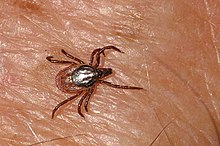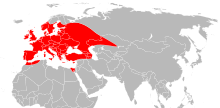Ixodes ricinus
| Ixodes ricinus | |
|---|---|
 |
|
| Ixodes ricinus complete view (starved) | |
 |
|
| Close-up view (engorged) | |
| Scientific classification | |
| Kingdom: | Animalia |
| Phylum: | Arthropoda |
| Class: | Arachnida |
| Subclass: | Acari |
| Order: | Ixodida |
| Family: | Ixodidae |
| Genus: | Ixodes |
| Species: | I. ricinus |
| Binomial name | |
|
Ixodes ricinus (Linnaeus, 1758) |
|
 |
|
| Range of I. ricinus (marked in red) in western Eurasia and North Africa | |
| External identifiers for Ixodes ricinus | |
|---|---|
| Encyclopedia of Life | 514939 |
| NCBI | 34613 |
| Also found in: | |
Ixodes ricinus, the castor bean tick, is a chiefly European species of hard-bodied tick. It may reach a length of 11 mm (0.43 in) when engorged with a blood meal, and can transmit both bacterial and viral pathogens such as the causative agents of Lyme disease and tick-borne encephalitis.
In common with other species of Ixodes, I. ricinus has no eyes and is not ornate; it has no festoons (wrinkles along the posterior margin). The palpi are longer than they are wide, and there is an anal groove above the anus. It has a hard dorsal shield which covers the entire opisthosoma (abdomen), but only part of it in females and nymphs.I. ricinus is the largest of the three common species of Ixodes in the British Isles (the other two being I. canisuga, the "British dog tick", and I. trianguliceps, the "vole tick"). Adult males are 2.4–2.8 millimetres (0.09–0.11 in) long, and unfed nymphs are 1.3–1.5 mm (0.05–0.06 in) long; females are 3.0–3.6 mm (0.12–0.14 in) long before feeding and 11 millimetres (0.43 in) long when engorged.
Ixodes ricinus is found across Europe and into neighbouring parts of North Africa and the Middle East, extending as far north as Iceland and as far east as parts of Russia. Its northern limit seems to be determined by environmental factors, including temperature, since a series of mild winters in Scandinavia coincided with an expansion northwards in the range of I. ricinus.
I. ricinus is most frequent in habitats where its hosts are plentiful, including woodlands, heaths and forests. It is most prevalent in relatively humid areas, and is absent from much of the Mediterranean Region where summers are dry.
...
Wikipedia
